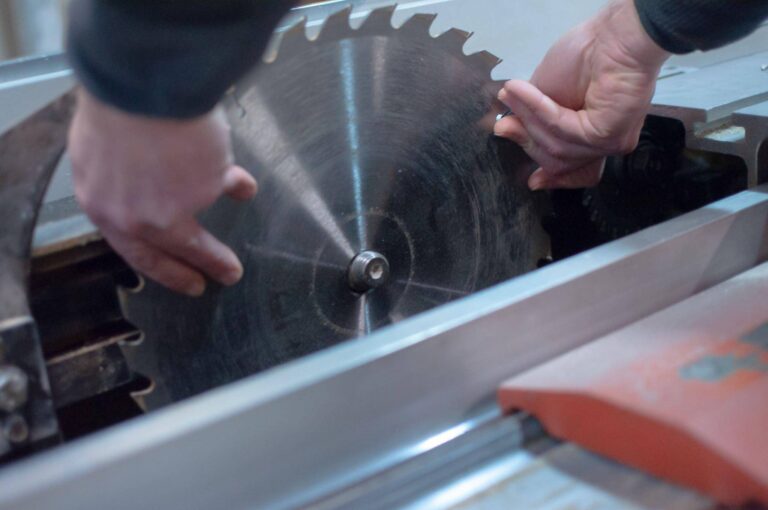Circular saw blades are an important tool for any DIYer or professional. A sharp circular saw blade makes cutting easier and ensures safety when working with this powerful tool.
Therefore, it is essential to regularly sharpen a circular saw blade to maintain its optimum performance.
This article will provide you with a step-by-step guide on sharpening the edges of a circular saw blade so that you can get the most out of it.
Sharpening a circular saw blade is only sometimes necessary, as replacing it altogether can be more efficient.
However, in cases where the blade has been subjected to small nicks or dullness over time, sharpening can save you money and prolong the lifespan of your blade.
The process involves removing the blade from the saw and using a specialized file to remove any excess metal and restore its sharp edges.
To begin sharpening your circular saw blade, ensure that you have a flat surface to work on and have secured the blade properly.
Next, use a marker pen to mark all teeth on one side of the blade so that you know which teeth have already been filed down.
Then carefully move along each tooth with your file using smooth strokes until all teeth are evenly sharpened. Repeat this process on the other side of the blade until all teeth are sharpened.
Knowing how to sharpen your circular saw blades properly can come in handy when your blades start losing their sharpness over time.
By following these simple steps, you can save money while ensuring that your blades last longer before needing replacement — ultimately leading to better performance for all your cutting needs.

Step By Step Guide To Sharpening A Circular Saw Blade
Tools Required To Sharpen The Saw
The right tools are essential for any task, and sharpening a saw is no different. Whether you’re a hobbyist woodworker or a professional carpenter, having quality tools to sharpen your saw can make all the difference in maintaining and using it properly.
- A ring spanner
- a triangular file
- two screw clamps
- a flat file
- a set of pliers
Steps:
Remove The Blades From The Saw
Removing the saw blade from a circular saw is an important prerequisite for sharpening it. Before starting the process, ensure you have a ring spanner of the correct size.
First, disconnect the power supply to remove the blade to avoid any accidental start-ups. Locate and loosen the nut holding the blade by turning it clockwise with a ring spanner.
Once you have loosened the nut, use your gloves to remove it carefully and any washers present.
Some models may require additional steps or tools to remove them safely. Check your manufacturer’s instructions before proceeding further.
Now Fix The Blades
To sharpen a circular saw blade, it’s essential to fix the blade to the workbench using screw clamps. This process ensures that the blade stays in place during sharpening and remains stable throughout the procedure.
The two screw clamps provide enough pressure to hold down the saw blade without damaging its teeth or structure.
To avoid any mishaps during this process, make sure that you use high-quality screw clamps that are ideal for heavy-duty applications like fixing a saw blade onto a workbench.
Also, ensure that your bench is sturdy enough to handle this task, as you don’t want any movement or vibrations while working with sharp tools.
With these precautions in mind, you can successfully fix your circular saw blades onto your workbench for sharpening again and again.
Trim The Circular Saw Teeth
The teeth of a saw blade are integral to its performance, and maintaining their shape is crucial for ensuring smooth and efficient cuts.
Over time, the teeth can become uneven due to wear and tear from constant use. Trimming them before sharpening is necessary to ensure they will be effectively sharpened.
Trimming the teeth involves removing any debris or buildup that may be present on the blade. This ensures that the blades are clean and ready for sharpening.
Once this step is complete, restoring each tooth’s original shape becomes easier as there will be no interference from dull or damaged areas.
Set The Teeth
Setting the teeth of a saw blade refers to bending each tooth alternately in opposite directions. This process creates a slightly wider kerf than the blade’s thickness, allowing for smooth and efficient cutting.
The saw will not cut effectively without setting the teeth and may become stuck in the workpiece.
You will need a saw set tool to set the teeth of a circular saw blade. This tool uses an anvil and hammer to bend each tooth at an angle.
The required set depends on the type of wood being cut and the thickness of the blade itself. It is important not to overdo it when setting your blade, as too much set can cause rough cuts or even damage your workpiece.
Sharpen The Teeth
Once the rows of teeth on a circular saw blade have been filed and set, the next step is to sharpen them.
This is a crucial process that ensures optimal cutting performance and longevity of the blade. One must use a triangular file with three to four faces to accomplish this task.
When using a triangular file, it is important to maintain the correct angle and pressure for each tooth.
This requires careful attention and patience, as rushing or applying too much pressure can result in an uneven or damaged edge.
Additionally, it is recommended to use a lubricant such as oil or wax during the sharpening process to reduce friction and prevent overheating.
Install The Teeth
Once the circular saw blade has been sharpened, it’s important to reinstall it correctly to ensure a smooth operation. The first step is to check for any damage or wear on the arbour flange and replace it if necessary.
Then, carefully slide the blade onto the arbour shaft and ensure it fits snugly against the shoulder of the arbour.
Next, you’ll need to tighten the arbour nut securely using a wrench or pliers. Be careful not to over-tighten, as this can cause damage to both the blade and saw. Once tightened, gently tug the blade to ensure it is firmly in place.
Conclusion
In conclusion, sharpening a circular saw blade is not an overly difficult task, but it does require some basic knowledge and the right tools.
Taking the time to sharpen your saw blade regularly will help you make cuts with greater accuracy and extend your saw blade’s life.
Be sure to read up on how to properly sharpen your saw blade, wear protective gear and follow all safety precautions. After a few practice runs, you’ll be ready to take on any sharpening job like a pro.

